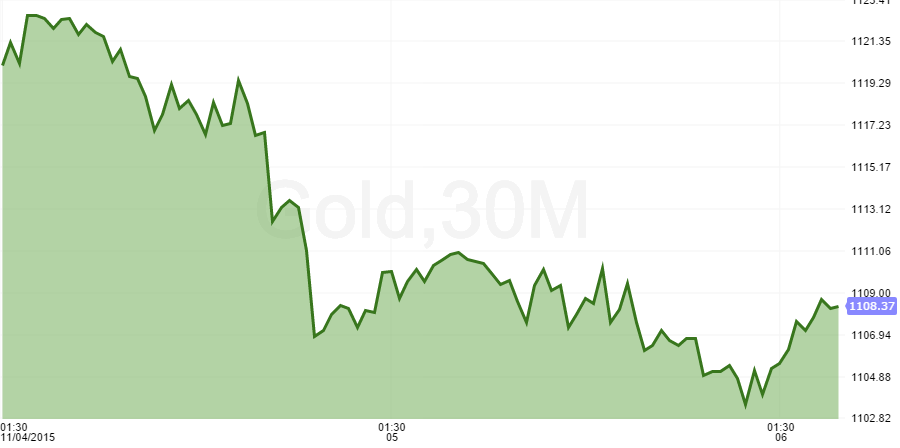By FXEmpire.com

Gold Fundamental Analysis April 6, 2012, Forecast
Analysis and Recommendations:
Gold recaptured some of its recent losses moving up to trade at 1629.65 an increase of 15.55.
Gold futures rebounded Thursday after investors bought into metals beaten down in the previous session on dashed expectations of further U.S. monetary stimulus.
Although gold prices may soon bottom if macro hedge funds or other investors sense that the market is becoming oversold, analysts believe that bullion prices rebound only on emerging-market demand or fresh official-sector buying. A gold price drop below $1,600/ounce could attract such buying,
Gold sank $57.90, or 3.5%, on Wednesday, ending at its lowest level since Jan. 9, while silver sank 6.7%, closing at the lowest level since mid-January.
The losses followed market disappointment that the Federal Reserve is unlikely to launch a third round of liquidity-boosting asset purchases.
Thursday’s gains, however, also came as some analysts said the Fed’s policy remains accommodative enough to support gold prices, even in the absence of further easing.
“Policy is already ultra-accommodative by conventional monetary standards and therefore gold-friendly. This may be overlooked or underestimated in the current selloff, we believe,” HSBC analyst James Steel wrote in a report.

Just a heads up since gold is volatile and will react to most economic indicators we will begin to post the daily calendar with events that could affect the price of gold. The gold price is sensitive to a number of scheduled U.S. and Euro area macroeconomic announcements–including retail sales, non-farm payrolls, and inflation. Gold’s high sensitivity to real interest rates and its unique role as a safe-haven and store of value typically leads to a counter-cyclical reaction to surprise news, in contrast to their commodities. It also shows a particularly high sensitivity to negative surprises that might lead financial investors to become more risk averse.
These results have a number of implications. To reduce the uncertainty of the return on gold transactions, traders may wish to time their orders flow so as to avoid the release of information that has been shown to affect prices. For longer-term market participants, these results provide confirmation of the pro-cyclical bias of many commodities and gold’s role as a safe-haven during periods of economic uncertainty.
Economic Events April 5, 2012 actual v. forecast
|
CHF |
CPI (MoM) |
0.6% |
0.4% |
0.3% |
|
EUR |
Dutch CPI (YoY) |
2.50% |
2.20% |
2.50% |
|
GBP |
Industrial Production (MoM) |
0.4% |
0.3% |
-0.6% |
|
GBP |
Manufacturing Production |
-1.0% |
0.1% |
-0.3% |
|
GBP |
Interest Rate Decision |
0.50% |
0.50% |
0.50% |
|
GBP |
BOE QE Total |
325B |
325B |
325B |
|
BRL |
Brazilian CPI (YoY) |
5.2% |
5.4% |
5.8% |
|
Building Permits (MoM) |
7.5% |
3.0% |
-11.4% |
|
|
CAD |
Employment Change |
82.3K |
10.0K |
-2.8K |
|
USD |
Initial Jobless Claims |
357K |
355K |
363K |
|
CAD |
Unemployment Rate |
7.2% |
8.0% |
7.4% |
|
USD |
Continuing Jobless Claims |
3338K |
3350K |
3354K |
|
CAD |
Ivey PMI |
63.5 |
66.0 |
66.5 |
|
GBP |
NIESR GDP Estimate |
0.1% |
0.1% |
Economic Events scheduled for April 6, 2012 that affect the European and American Markets
13:30 USD Average Hourly Earnings (MoM)
13:30 USD Private Nonfarm Payrolls
Average Hourly Earnings measures the change in the price businesses pay for labor, not including the agricultural sector. Private Nonfarm Payrolls measures the change in the number of total number of paid U.S. workers of any business, excluding general government employees, private household employees, employees of nonprofit organizations that provide assistance to individuals and farm employees.
13:30 USD Nonfarm Payrolls
13:30 USD Unemployment Rate
Nonfarm Payrolls measures the change in the number of people employed during the previous month, excluding the farming industry. Job creation is the foremost indicator of consumer spending, which accounts for the majority of economic activity. The Unemployment Rate measures the percentage of the total work force that is unemployed and actively seeking employment during the previous month.
Government Bond Auctions
None scheduled until after April 10, 2012 due to holiday schedule
Private Nonfarm Payrolls
Average Hourly Earnings measures the change in the price businesses pay for labor, not including the agricultural sector. Private Nonfarm Payrolls measures the change in the number of total number of paid U.S. workers of any business, excluding general government employees, private household employees, employees of nonprofit organizations that provide assistance to individuals and farm employees.
13:30 USD Nonfarm Payrolls
13:30 USD Unemployment Rate
Nonfarm Payrolls measures the change in the number of people employed during the previous month, excluding the farming industry. Job creation is the foremost indicator of consumer spending, which accounts for the majority of economic activity. The Unemployment Rate measures the percentage of the total work force that is unemployed and actively seeking employment during the previous month.
Government Bond Auctions
None scheduled until after April 10, 2012 due to holiday schedule
Originally posted here



